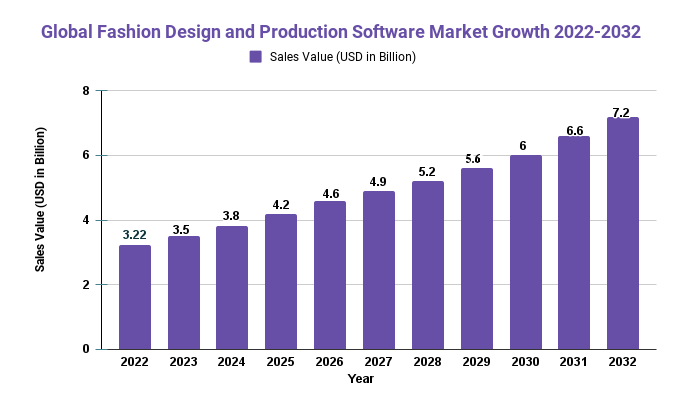Fashion Design and Production Software Market Sales to Expand at 8.6% CAGR Through 2032

Page Contents
Market Overview
Published Via 11Press: The Fashion Design and Production Software Market size is expected to be worth around USD 7.2 Bn by 2032 from USD 3.22 Bn in 2022, growing at a CAGR of 8.6% during the forecast period from 2022 to 2032.
The fashion industry has undergone a massive transformation in recent years, thanks to the rise of technology. One of the most significant changes is the advent of fashion design software. The fashion design software market has grown rapidly in recent years, and it shows no signs of slowing down anytime soon. This shift in the landscape has led to more efficient and effective processes for designers, from creating sketches to producing finished designs.
Fashion design software offers many features that make designing easier and more accessible than ever before. With these tools, designers can create digital sketches, develop 3D designs, adjust patterns with ease, and even simulate how a garment will look on a model or mannequin. These capabilities have revolutionized prototyping and testing procedures while reducing costs drastically compared to traditional methods.
Request For Sample Report Here: https://market.us/report/fashion-design-and-production-software-market/request-sample/

Key Takeaways
- Growing Demand: The fashion design software market is experiencing significant expansion due to the increasing need for faster and more efficient design processes in the fashion industry.
- Adoption of 3D design tools: Fashion designers are increasingly turning towards 3D design tools for more realistic and accurate representations of their creations.
- Cloud-Based Solutions: As more designers opt for cloud-based fashion design software solutions, they provide greater accessibility and versatility when working remotely or collaborating with teams from different locations.
- Integration With Other Tools: Fashion design software is being integrated with other applications like product lifecycle management (PLM) and enterprise resource planning (ERP) systems to streamline the entire design and production process.
- Cost and Complexity: Fashion design software can offer numerous advantages, however, it's costly and complex to set up and run, which may prevent smaller fashion businesses from adopting it.
- Competitive Landscape: The fashion design software market is highly competitive, with a number of players offering various solutions with differing features and functionalities. As new technologies emerge and customer needs shift, the market is expected to continue growing and evolving.
Regional Analysis
- North America The fashion design software market in North America is expected to experience rapid growth due to the presence of several key players and the increased adoption of advanced technologies such as 3D design tools and cloud-based solutions.
- Europe is projected to experience significant growth in the fashion design software market due to increasing demand for sustainable and eco-friendly fashion that necessitates more efficient and streamlined design processes.
- The Asia Pacific region is expected to experience significant growth in the fashion design software market due to the increasing adoption of technology and digitalization within this sector. It boasts several emerging economies like China and India which are rapidly expanding their fashion markets.
- Middle East and Africa The fashion design software market in the Middle East and Africa are expected to experience steady growth due to increasing demand for luxury fashion as well as the expanding fashion industry in countries like the United Arab Emirates and South Africa.
- Latin America The fashion design software market in Latin America is projected to expand steadily due to the increasing adoption of technology and growing fashion industries in countries such as Brazil and Mexico.
- Overall, the fashion design software market is expected to experience strong growth across all regions due to an increasing need for faster and more efficient design processes in this sector.
Browse the summary of the report and Complete Table of Contents (TOC): https://market.us/report/fashion-design-and-production-software-market/table-of-content/
Drivers
- With the increasing demand for faster and more efficient design processes: Fashion designers are under increasing pressure to produce new designs quickly and efficiently. Fashion design software can help them achieve this by providing tools that streamline the design process and make it easier to iterate on designs.
- Growing adoption of 3D design tools: 3D design tools is becoming increasingly popular among fashion designers as they allow them to create more realistic and accurate representations of their designs. This can help to reduce the number of physical prototypes that need to be created, saving time and money in the design process.
- Rising trend towards sustainability: The fashion industry is increasingly focused on sustainability, with consumers demanding more eco-friendly and sustainable products. Fashion design software can help designers create more sustainable designs by providing tools that allow them to optimize fabric usage and reduce waste.
- Increasing adoption of cloud-based solutions: Cloud-based fashion design software solutions are becoming increasingly popular, as they offer greater accessibility and flexibility for designers working remotely or collaborating with teams in different locations.
- Integration with other tools: Fashion design software is being integrated with other tools such as product lifecycle management (PLM) and enterprise resource planning (ERP) systems to streamline the entire design and production process.
- Technological advancements: Advancements in technology, such as artificial intelligence and machine learning, are driving innovation in the fashion design software market, enabling designers to create more complex designs and automate certain aspects of the design process.
- Overall, the fashion design software market is being driven by a range of factors, all of which are contributing to the growing adoption of technology in the fashion industry and the increasing demand for faster, more efficient, and sustainable design processes.
Restraints
- High cost of implementation, The cost of implementing fashion design software can be significant, which may limit its adoption among smaller fashion businesses that cannot afford the expense.
- Complexity, Fashion design software can be complex to implement and maintain, requiring specialized knowledge and skills. This can make it difficult for some fashion businesses to adopt the technology, particularly those that lack the necessary resources or expertise.
- Integration challenges, Integrating fashion design software with other tools such as product lifecycle management (PLM) and enterprise resource planning (ERP) systems can be challenging and time-consuming, which may limit adoption.
- Limited customization options, Some fashion design software solutions may have limited customization options, which can limit the ability of designers to create unique and personalized designs.
- Limited adoption among traditionalists, Some designers and fashion businesses may be hesitant to adopt new technologies, preferring to stick with traditional design methods. This may limit the adoption of fashion design software, particularly among older or more established businesses.
- Security concerns, The use of cloud-based fashion design software solutions can raise security concerns, particularly in relation to the protection of intellectual property and confidential design information.
- Overall, while the fashion design software market is growing rapidly, there are a number of factors that may limit its adoption among certain segments of the fashion industry. Addressing these restraints will be important in ensuring that the technology continues to grow and evolve in the years to come.
Opportunities
- Growing Demand for Customization: As consumers increasingly desire personalized and customized items, fashion design software can assist designers in meeting this demand by giving them the tools to craft unique and personalized designs.
- Expansion into Emerging Markets: The fashion industry is experiencing rapid growth in emerging nations such as China, India, and Brazil. Fashion design software vendors can take advantage of this by offering solutions tailored to these regions' specific requirements.
- Integration with Emerging Technologies: Fashion design software vendors can integrate their solutions with cutting-edge technologies like augmented reality (AR) and virtual reality (VR), giving designers new tools and capabilities for creating and presenting their designs.
- Focus on Sustainability: With sustainability becoming a growing concern in the fashion industry, fashion design software vendors can focus on developing tools and solutions that enable designers to create more eco-friendly and sustainable designs.
- Collaboration and Teamwork: Fashion design software helps designers collaborate more efficiently with colleagues and partners around the world, encouraging greater creativity during the design process.
- Application in Other Industries: Fashion design software can also be utilized by other industries such as interior design and automotive design, providing new opportunities for vendors in these markets.
- Overall, the fashion design software market presents numerous opportunities for growth and expansion as the industry continues to adapt and adopt new technologies. Vendors who can seize these advantages are likely to be successful in the years ahead.
Challenges
- Increasing competition: The fashion design software market is becoming increasingly competitive, with a growing number of vendors offering similar solutions. This can make it difficult for new entrants to gain market share and for existing vendors to differentiate themselves.
- Limited adoption among smaller businesses: Small and medium-sized fashion businesses may not have the resources or expertise to implement and maintain fashion design software solutions, limiting the adoption of the technology among these segments.
- Rapidly evolving technology: The fashion industry is rapidly evolving, and fashion design software vendors must keep pace with new trends and technologies to remain competitive. This can require significant investments in research and development, which can be challenging for smaller vendors.
- Intellectual property concerns: Fashion design software solutions can make it easier for designs to be copied and replicated, raising concerns about intellectual property protection and infringement.
- Resistance to change: Some fashion businesses and designers may be resistant to change and prefer traditional design methods, limiting the adoption of fashion design software solutions.
- Cybersecurity risks: The use of cloud-based solutions can raise cybersecurity concerns, particularly in relation to the protection of confidential design information and intellectual property.
- Overall, the fashion design software market faces a range of challenges that must be addressed by vendors and industry stakeholders. Addressing these challenges will be important in ensuring the continued growth and adoption of technology in the fashion industry.
Report Scope
| Report Attribute | Details |
| The market size value in 2022 | USD 3.22 Bn |
| Revenue forecast by 2032 | USD 7.2 Bn |
| Growth Rate | CAGR Of 8.6% |
| Regions Covered | North America, Europe, Asia Pacific, Latin America, and Middle East & Africa, and the Rest of the World |
| Historical Years | 2017-2022 |
| Base Year | 2022 |
| Estimated Year | 2023 |
| Short-Term Projection Year | 2028 |
| Long-Term Projected Year | 2032 |
Key Market Segments
Type
- Cloud-based
- On-premise
Application
- Large Enterprise
- SMB
Key Market Players included in the report:
- Adobe
- Autometrix
- Corel
- Autodesk
- CGS
- Tukatech
- Vetigraph
- Computer Systems Odessa
- C-DESIGN
- Modern HighTech
- Tricycle
- F2iT
- Wilcom
- K3 Software Solutions
- PatternMaker Software
- Polygon Software
- SnapFashun Group
- HobbyWare
- Gerber Technology
Frequently Asked Questions
What is the market study period?
The Fashion Design and Production Software Market is studied from 2017 – 2032.
What is the growth rate for the Fashion Design and Production Software Market?
The Fashion Design and Production Software Market is growing at a CAGR of 8.6%
Who are the major players in the Fashion Design and Production Software Market?
Adobe, Autometrix, Corel, Autodesk, CGS, Tukatech, Vetigraph, Computer Systems Odessa, C-DESIGN, Modern HighTech, Tricycle, F2iT, Wilcom, K3 Software Solutions, PatternMaker Software, Polygon Software, SnapFashun Group, HobbyWare, Gerber Technology
The team behind market.us, marketresearch.biz, market.biz and more. Our purpose is to keep our customers ahead of the game with regard to the markets. They may fluctuate up or down, but we will help you to stay ahead of the curve in these market fluctuations. Our consistent growth and ability to deliver in-depth analyses and market insight has engaged genuine market players. They have faith in us to offer the data and information they require to make balanced and decisive marketing decisions.